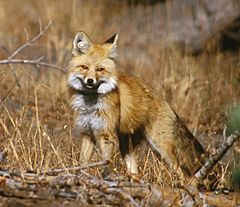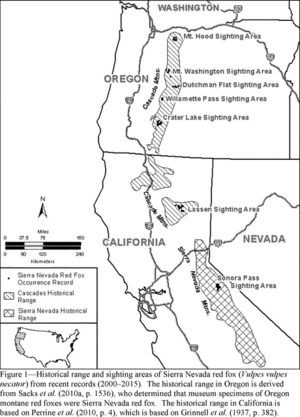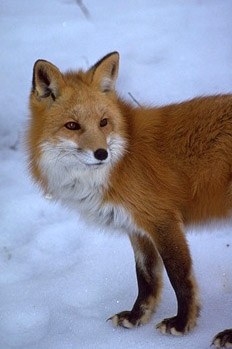Sierra Nevada red fox facts for kids
Quick facts for kids Sierra Nevada red fox |
|
|---|---|
 |
|
| A Sierra Nevada red fox in Lassen Volcanic National Park, 2002 | |
| Scientific classification | |
| Kingdom: | |
| Phylum: | |
| Class: | |
| Order: | |
| Family: | |
| Tribe: | |
| Genus: | |
| Species: |
V. vulpes
|
| Subspecies: |
V. v. necator
|
| Trinomial name | |
| Vulpes vulpes necator Merriam, 1900
|
|
 |
|
| Sierra Nevada red fox historical range and recent sightings | |
The Sierra Nevada red fox (Vulpes vulpes necator) is a special kind of red fox. It's also called the High Sierra fox. This animal is one of the most endangered mammals in North America.
Scientists believe there are only about 29 adult foxes living near Sonora Pass in California. Another group, called the Southern Cascades group, has about 42 adults near Lassen Volcanic National Park. There are also some foxes in five areas of Oregon, but we don't know how many. No other groups of these foxes are known to exist.
California made it illegal to trap Sierra Nevada red foxes in 1974. In 1980, the state officially listed them as a threatened animal. In Oregon, these foxes are considered a "sensitive species" by the U.S. Forest Service. The group in the Sierra Nevada is protected under a special law, but the Southern Cascades group is not.
Contents
What Does the Sierra Nevada Red Fox Look Like?
Sierra Nevada red foxes are a bit smaller and lighter than other red foxes that live in lower areas of North America. Their coat can be red, cross, or silver. The red fur often has a grayish-blonde color, which is common for foxes living in mountains.
All three fur colors can be found in the Oregon Cascade and Sonora Pass fox groups. However, only red foxes have been seen in the Lassen group. Their paw pads are covered in fur. This helps them travel over snow. Sierra Nevada red foxes live longer than other red foxes, often five or six years. Female foxes don't always have babies every year.
In the early 1900s, people wanted red fox fur because it was softer than the fur of California's gray fox (Urocyon cinereoargenteus).
Where Do Sierra Nevada Red Foxes Live?
Sierra Nevada red foxes are one of three types of mountain foxes in North America. They live in the Cascade Mountains south of the Columbia River. They also live in California's Sierra Nevada mountain range.
In 1937, a scientist named Joseph Grinnell found separate groups of these mountain foxes. They were in the Oregon Cascades, Mount Shasta, Lassen Peak, and the Sierra Nevada. After that, people didn't study these foxes much for about 60 to 75 years.
The Lassen fox group was found again in 1993. Then, a Sierra Nevada group was found near Sonora Pass in 2010. The Oregon Cascades group was rediscovered in 2011. The Lassen and Sonora Pass groups are separate from each other. We don't know if any foxes are still living at Mount Shasta.
Scientists are still studying how far these foxes spread. In Oregon, new studies started in 2012 and 2013 after foxes were seen near Mount Hood and Central Oregon. Recent DNA evidence also suggests that foxes have moved into western Oregon since the 1940s. In California, foxes were seen in northern Yosemite National Park in 2014-2015. They were also seen in the Stanislaus National Forest in late 2015 and in Lassen Volcanic National Park in 2018. The first two areas are close to Sonora Pass, but we don't know if these foxes are part of the Sonora Pass group.
What Do Sierra Nevada Red Foxes Eat?
A study in 2005 looked at the foxes living on Mount Lassen. It found that these foxes hunt at night. They mostly eat mammals, like rodents and mule deer. They also eat birds, insects, and pinemat manzanita berries when they are available. The foxes almost never ate lagomorphs (like hares, rabbits, or pikas).
A Brief History of the Sierra Nevada Red Fox
The three types of mountain foxes became separate after the Wisconsin glaciation, which was about 15,000 to 20,000 years ago. The Columbia River might have separated the Cascade and Sierra Nevada red foxes. Before 2010, people thought all mountain red foxes in Oregon were Cascade red foxes. Because of this, older books might show the wrong areas for where these foxes lived.
One of the first times a Sierra Nevada red fox was trapped was in 1844-1845. A man named Moses Schallenberger spent the winter at Donner Pass. He caught about one red fox every two days.
Images for kids
See also
 In Spanish: Zorro rojo de Sierra Nevada para niños
In Spanish: Zorro rojo de Sierra Nevada para niños



